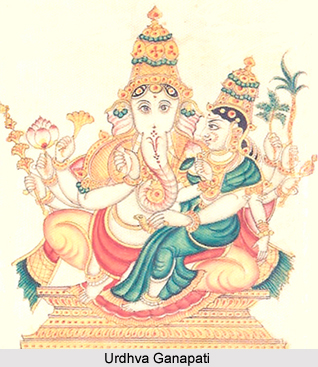 Urdhva Ganapati is a Tantric god and one of the thirty-two forms of Lord Ganesha. This is the sixteenth form of the Lord. He is depicted in golden complexion and is considered to be the remover of obstacles. Lord Urdhva Ganapati has eight arms and holds various articles in His hands, such as, a lotus, His own broken tusk, a sprig of paddy, a sugar cane bow, a blue lily, a gada or mace and an arrow. Urdhva Ganapati is accompanied by his consort Shakti who is seated on his left lap. The Lord gently embraces Her with His main left hand. In this incarnation, Lord Ganesha is seated in a tantric posture.
Urdhva Ganapati is a Tantric god and one of the thirty-two forms of Lord Ganesha. This is the sixteenth form of the Lord. He is depicted in golden complexion and is considered to be the remover of obstacles. Lord Urdhva Ganapati has eight arms and holds various articles in His hands, such as, a lotus, His own broken tusk, a sprig of paddy, a sugar cane bow, a blue lily, a gada or mace and an arrow. Urdhva Ganapati is accompanied by his consort Shakti who is seated on his left lap. The Lord gently embraces Her with His main left hand. In this incarnation, Lord Ganesha is seated in a tantric posture.
When a devotee worships this form of Lord Ganesha, he is blessed with the ability to overcome difficulties and attain success in life. There are several temples of Lord Ganesha in India where the Urdhva Ganapati form is worshipped. Some of the popular temples include the temples in Nanjangud and Chamarajanagar in Mysore, Karnataka; and the Shri Mahalingeshwara Temple in Madurai, Tamil Nadu.
The Urdhva Ganapati is prayed and worshipped by the recitation of a Mantra or devotional hymn. The Urdhva Ganapati Mantra is mentioned as follows-
Kalhaara Shali Kamalekshuka Chapa Bandanta
Prarohakagadi Kanakojwalangaha
Alinganaodhatakaro Harithangashtaya Devya
Karotu Shubhaha Murdhva Ganadhipo Mey.
This article is a stub. You may enrich it by adding more information to it. You can send your write-up at content@indianetzone.com




















